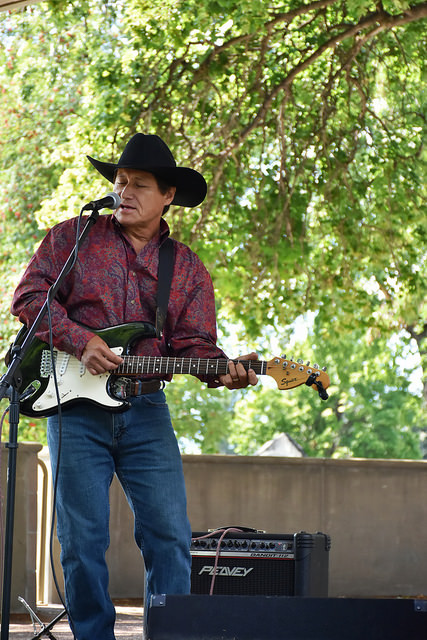Tax talk: Baker City, Baker County officials debate future of lodging tax revenue
Published 8:11 am Tuesday, September 10, 2024

- Baker City owns the 18-hole Quail Ridge Golf Course in the southwest part of the city.
The tax that guests pay when they stay at most Baker County motels, vacation rentals and other lodging businesses has generated record amounts of revenue the past three fiscal years, and Baker City officials believe the city should get a guaranteed share of that money each year.
Trending
But their counterparts at Baker County, which has administered the transient lodging tax under an agreement with the city that dates to 2006, are concerned that the city’s request could detract from the county’s tourism marketing campaign that has contributed to the record-setting revenue.
The debate has resulted in a series of 2-1 votes by the Baker County Board of Commissioners this year on motions to give some lodging tax money to the city.
And Christina Witham, the commissioner who voted against three recent requests from the city for $750,000 in lodging tax dollars, has branded as a “threat” a city suggestion that it might withdraw from the 2006 agreement and set up a separate lodging tax for establishments within the city limits.
Trending
(Commission Chairman Shane Alderson and Commissioner Bruce Nichols voted for the motions to give the $750,000 to the city — $450,000 to replace the irrigation system at the city-owned Quail Ridge Golf Course, $150,000 for new restrooms at Geiser-Pollman Park, and $150,000 for economic development work.)
Baker City Mayor Randy Daugherty said he doesn’t want the city to pull out of the agreement.
He said he likes the current arrangement in which the county administers the lodging tax and oversees the marketing campaign designed to bring overnight visitors to the city and county.
But Daugherty contends that because a majority of the lodging taxes are paid by guests who stay in Baker City — 61.1% in the most recent fiscal year, according to county records, although city officials have pegged the figure at around 80% — and because the county amassed a cash carryover of nearly $2 million in the two departments that get almost all lodging tax revenue, the city’s request for an annual percentage of the revenue is reasonable.
“I want to leave it (the 2006 agreement) as it is because it benefits the entire county,” Daugherty said on Monday, Sept. 9. “But the city would like to receive some of the funds each year.”
Keeping the city-county agreement in place is one point on which Witham and Daugherty agree.
But Witham worries about the long-term ramifications of changing that agreement to ensure the city gets a percentage of lodging taxes each year.
There’s no guarantee that revenue will continue the rising trend of the past three years, Witham said.
Although the county doesn’t have statistics for August, Witham said anecdotal reports show that visitor numbers have dropped in the latter part of the summer due to the unprecedented rash of wildfires.
Witham said that although she understands why the city is asking for a share of revenue, she believes the overriding goal should be to maintain the system that has been in place during a period when tax collections have more than doubled since the downturn resulting from the pandemic.
Diverting money from that system to grant the city’s request means there would be less money for the county to continue its tourism marketing and economic development efforts, she said.
“Conceptually, I have no problem with the city getting some of the tax money,” Witham said on Sept. 9. “But we need to have a discussion. We need to go back to the table. I am open to a conversation but it has to be reasonable.”
How the lodging tax works
Guests pay the tax when they stay at lodging establishments, including bed and breakfasts, RV parks and campgrounds.
The tax is 7% of the rental rate.
(County commissioners have discussed increasing the rate to 9% but have not taken any action.)
The lodging tax is charged in Baker City, Halfway, Sumpter, Unity and unincorporated parts of the county.
From 2006-19, annual revenue ranged from $385,000 to $576,000, with an average of $439,000.
Tax collections dipped to $408,000 in the 2019-20 fiscal year (which runs from July 1 to June 30). In April 2020, the height of restrictions due to COVID-19, revenue plummeted to $8,360, the lowest total for any month on record.
But revenue began to rebound relatively rapidly.
Collections for the 2020-21 fiscal year totaled $538,000. That was the third-highest yearly total since the city-county agreement was signed in 2006.
The upward trend has accelerated since.
Revenue in fiscal 2021-22 jumped by 33%, to a then-record $715,000.
As the pandemic waned, revenue continued to rise, with a 20% increase, to $860,000, in fiscal 2022-23.
The trajectory flattened a bit in the 2023-24 fiscal year, but tax revenue rose by 11%, to a new record of $954,000. Monthly revenue topped $100,000 in June, July, August and September 2023, including an all-time record of $130,404 in July. Prior to that fiscal year, tax revenue exceeded $100,000 in only one month, July 2022.
Tyler Brown, chairman of the county’s transient lodging tax committee, said last winter that he believes multiple factors have driven the record tax revenue. In addition to more people visiting and staying overnight, Brown noted that inflation has boosted rental rates. The number of vacation rental homes in the county has also increased.
Alderson, chairman of the county board of commissioners, said the revenue trend is a testament to the county’s tourism marketing campaign.
The county’s lodging tax ordinance restricts how the money is spent.
The bulk — 70% — must be used for tourism marketing or tourism-related facilities (including the golf course and public parks).
Another 25% goes to economic development.
And the county can keep up to 5% of lodging taxes to administer the program, which includes collecting the tax and tracking revenue.
Daugherty said the city’s request to receive a percentage of lodging taxes each year was prompted in part by the amount of money the county has amassed over the past few years.
During the first part of the pandemic, when few people were traveling for leisure, the county cut back on marketing. As tax revenue rebounded following the one-year downturn, the cash carryover increased.
As required by the ordinance, the county diverts 95% of lodging taxes to two departments — marketing and economic development.
The marketing budget had a beginning balance of $1,560,000 for the fiscal year that started July 1, 2024.
The economic development budget had a beginning balance of $396,000.
The county uses lodging tax revenue for three separate contracts.
Jessica Hobson is the tourism marketing director, working under the Travel Baker County moniker. The marketing budget includes $70,000 for the contract.
The Baker County Chamber of Commerce operates the visitors center at 490 Campbell St., near the freeway, under a contract for about $87,000 per year.
The county’s contract with Bryan Tweit as economic development director is for $56,760 per year.
This year’s budget also includes $80,000 for marketing for Baker City Downtown.
The budget for the current year also includes separate lines for a variety of tourism projects, including:
• $40,000 for grants for county events.
• $10,000 for newspaper adverting out of the county.
• $10,000 for multimedia and radio advertising.
• $15,000 for social network/internet marketing.
• $12,000 for Travel Baker County merchandise.
• $20,000 for Baker County visitor guide.
• $15,000 for cooperative marketing with the Eastern Oregon Visitor Association.
• $32,000 for advertising in travel periodicals.
• $15,000 for brochure distribution.
• $51,590 for “wayfinding,” such as signs and maps.
• $10,000 each for marketing for cycling, arts and culture and ag tourism/culinary.
• $10,000 for sporting events promotion.
Alderson said he voted, along with Nichols, to give the city $750,000 for the golf course irrigation system, park restrooms and economic development because he believes the county could afford to do so without cutting back on tourism marketing and economic development.
“I think what the county has done with the money to the city has been reasonable,” Alderson said on Sept. 6.
But like Witham, who voted against each of those transfers, Alderson is leery of making long-term commitments with no certainty about how much money the tax will generate.
“I want to keep the momentum going,” Alderson said. “It’s vital that we keep the marketing the way it is.”
The city’s most recent request was $150,000 for economic development.
Commissioners approved the request on Sept. 4 by the same 2-1 vote, with Alderson and Nichols voting yes, and Witham opposed.
During that meeting, Witham noted that the county had earlier in the year given the city $450,000 for the golf course irrigation system, $150,000 for the Geiser-Pollman Park restrooms, and $80,000 for Baker City Downtown marketing.
Witham said she is “tired of the threat” that the city could withdraw from the 2006 agreement (it requires 60 days’ notice for either party to pull out).
Witham said the county should require that the city explain how it uses the $150,000, to ensure that the money goes for economic development.
Jerry Peacock, chairman of the Baker County Economic Development Council, said the council recommended commissioners give the $150,000 to the city.
Considering the county’s economic development budget had a $396,000 beginning balance, Peacock said the council felt the city’s request was “feasible.”
There is enough money to give the city $150,000 and continue the contract with Tweit, whose work as economic developer benefits the city as well as the rest of the county, Peacock said.
He noted, however, that the council’s recommendation was to review each year any request from the city for a share of the economic development budget. The council did recommend that the transfer be guaranteed every year, as Daugherty has proposed.
What will the city ask for?
In a May 30 letter to county commissioners, Baker City Manager Barry Murphy proposed to negotiate changes to the 2006 city-county agreement dating to 2006 that would guarantee the city receives a share of each year’s lodging tax revenue.
Murphy said in June that he wants the city to remain in partnership with the county, and that he does not want the city to withdraw from the 2006 pact and administer its own, city-only, lodging tax.
Murphy contended that about 80% of lodging taxes are paid by people staying at businesses within the Baker City limits.
The county’s figures put that figure at about 61% for the most recent fiscal year.
Pinpointing the percentage is difficult because companies that oversee many vacation rentals don’t report tax payments at the city level.
Murphy proposed the city receive about $200,000 annually in lodging taxes. The money, he said, could help bolster the city’s general fund. That fund, which includes the police and fire departments, has faced a shortfall that prompted the city council to impose a monthly public safety fee starting June 1 of this year. The fee is $10 per month for homes and $20 for businesses.
Daugherty said he thinks the city’s share should be a percentage, rather than a set amount, to reflect changes in revenue.
The dispute between the city and county isn’t limited to percentages.
Daugherty contends that the city is the “hub” of the county’s tourism economy and that the city should as a result receive a guaranteed share of lodging tax revenue.
But Alderson said it’s inevitable that a majority of the taxes are paid by people staying overnight in Baker City because that’s where most of the lodging establishments area.
He argues that some visitors book rooms in Baker City even if their main destination is elsewhere in the county — the Sumpter Dredge, for instance, or Hells Canyon, Halfway, Brownlee Reservoir, Oregon Trail Interpretive Center or Anthony Lakes.
In any case, Alderson, like fellow commissioner Witham, believes the ultimate question is how large the city’s share of lodging tax revenue should be.
Alderson said he’s not opposed to changing the 2006 city-county agreement so long as doing so doesn’t force the county to slash its tourism marketing and economic development campaigns.
The record tax revenues, he said, show that the county’s approach is working.
Daugherty said he wants the city council to “take a break” from the lodging tax issue for several weeks.
He agrees with Witham that city and county officials need to meet to discuss options.
Daugherty said he hopes the city will have a proposal to present to county commissioners by the end of the year. His goal is to have a revised city-county agreement for the lodging tax, including a guaranteed pass-through of revenue to the city each year, in place when the next fiscal year starts on July 1, 2025.
He said he’s optimistic that officials can come up with a deal that gives the city a reliable source of annual revenue while still allowing the county to continue spending about the same amount on tourism marketing and economic development.
Witham agrees that such an agreement is possible.
But, she said, “the devil is in the details.”
Baker County’s transient lodging tax ordinance, and an Oregon law, exempts people from paying lodging taxes if they stay in a lodging establishment for more than 30 straight days. That can include, for example, construction workers, traveling nurses, wildland firefighters and others.









